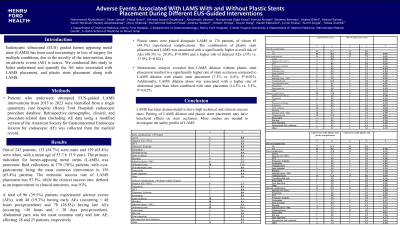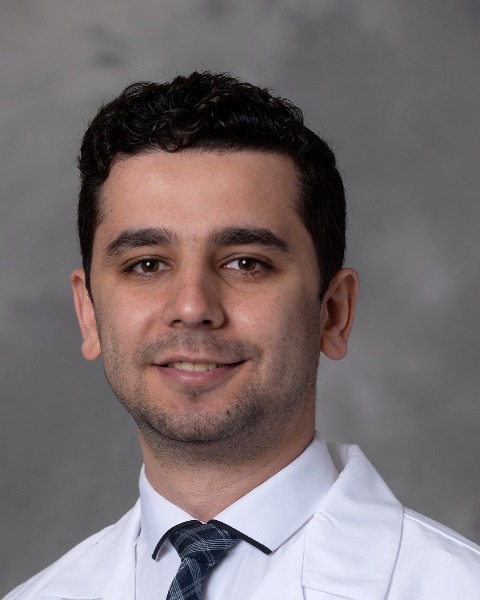Monday Poster Session
Category: Interventional Endoscopy
P2756 - Adverse Events Associated With LAMS With and Without Plastic Stents Placement During Different EUS-Guided Interventions
Monday, October 28, 2024
10:30 AM - 4:00 PM ET
Location: Exhibit Hall E

Has Audio

Mohammed Abusuliman, MD
Henry Ford Health
Detroit, MI
Presenting Author(s)
Mohammed Abusuliman, MD1, Taher Jamali, MD2, Faisal Nimri, MD2, Ammad Javaid. Chaudhary, MD1, Abdulmalik Saleem, MD1, Muhammad Saad Faisal, MD1, Ahmad Alomari, MD2, Sheema Rehman, DO2, Khaled Elfert, MD3, Ahmed Salem, MBBCh4, Sarah Meribout, MD4, Hazem Abosheaishaa, MD5, Ahmed M. Ibrahim, MD6, Omar Shamaa, MD1, Muhammad Salman Faisal, MD1, Andrew Watson, MD1, Robert Pompa, MD1, Duyen Dang, MD1, Mazen Elatrache, MD7, Cyrus Piraka, MD1, Sumit Singla, MD2, Tobias Zuchelli, MD2
1Henry Ford Health, Detroit, MI; 2Henry Ford Hospital, Detroit, MI; 3West Virginia University, Morgantown, WV; 4Maimonides Medical Center, Brooklyn, NY; 5Icahn School of Medicine at Mount Sinai, Queens, NY; 6Trinity Health Ann Arbor Hospital, Ypsilanti, MI; 7Henry Ford Health, Dearborn, MI
Introduction: Endoscopic ultrasound (EUS) guided lumen apposing metal stent (LAMS) has been used increasingly in lieu of surgery for multiple conditions, due to the novelty of the intervention, data on adverse events (AE) is scarce. We conducted this study to better understand and quantify the AE rates associated with LAMS placement, and plastic stent placement along with LAMS.
Methods: Patients who underwent attempted EUS-guided LAMS interventions from 2015 to 2023 were identified from a single quaternary care hospital (Henry Ford Hospital) endoscopic procedure database. Retrospective demographic, clinical, and procedure-related data (including AE data using a modified version of the American Society for Gastrointestinal Endoscopy lexicon for endoscopic AE) was collected from the medical record.
Results: Out of 243 patients, 133 (54.7%) were male and 159 (65.4%) were white, with a mean age of 53.7 ± 15.9 years. The primary indication for lumen-apposing metal stents (LAMS) was pancreatic fluid collections in 170 (70%) patients, with cyst-gastrostomy being the most common intervention in 159 (65.4%) patients. The technical success rate of LAMS placement was 97.5%, while the clinical success rate, defined as an improvement in clinical outcomes, was 93%.
A total of 96 (39.5%) patients experienced adverse events (AEs), with 48 (19.7%) having early AEs (occurring < 48 hours post-procedure) and 70 (28.8%) having late AEs (occurring >48 hours and < 30 days post-procedure). Abdominal pain was the most common early and late AE, affecting 28 and 25 patients, respectively.
Plastic stents were placed alongside LAMS in 176 patients, of whom 85 (48.3%) experienced complications. The combination of plastic stent placement and LAMS was associated with a significantly higher overall risk of AEs (48.3% vs. 29.9%, P=0.009) and a higher risk of delayed AEs (33% vs. 17.9%, P=0.021).
Multivariate analysis revealed that LAMS dilation without plastic stent placement resulted in a significantly higher rate of stent occlusion compared to LAMS dilation with plastic stent placement (7.3% vs. 0.8%, P=0.021). Additionally, LAMS dilation alone was associated with a higher rate of abdominal pain than when combined with stent placement (14.5% vs. 5.5%, P=0.027).
Discussion: LAMS has been demonstrated to have high technical and clinical success rates. Pairing of LAMS dilation and plastic stent placement may have beneficial effects on stent occlusion. More studies are needed to investigate the safety profile of LAMS.
Note: The table for this abstract can be viewed in the ePoster Gallery section of the ACG 2024 ePoster Site or in The American Journal of Gastroenterology's abstract supplement issue, both of which will be available starting October 27, 2024.
Disclosures:
Mohammed Abusuliman, MD1, Taher Jamali, MD2, Faisal Nimri, MD2, Ammad Javaid. Chaudhary, MD1, Abdulmalik Saleem, MD1, Muhammad Saad Faisal, MD1, Ahmad Alomari, MD2, Sheema Rehman, DO2, Khaled Elfert, MD3, Ahmed Salem, MBBCh4, Sarah Meribout, MD4, Hazem Abosheaishaa, MD5, Ahmed M. Ibrahim, MD6, Omar Shamaa, MD1, Muhammad Salman Faisal, MD1, Andrew Watson, MD1, Robert Pompa, MD1, Duyen Dang, MD1, Mazen Elatrache, MD7, Cyrus Piraka, MD1, Sumit Singla, MD2, Tobias Zuchelli, MD2. P2756 - Adverse Events Associated With LAMS With and Without Plastic Stents Placement During Different EUS-Guided Interventions, ACG 2024 Annual Scientific Meeting Abstracts. Philadelphia, PA: American College of Gastroenterology.
1Henry Ford Health, Detroit, MI; 2Henry Ford Hospital, Detroit, MI; 3West Virginia University, Morgantown, WV; 4Maimonides Medical Center, Brooklyn, NY; 5Icahn School of Medicine at Mount Sinai, Queens, NY; 6Trinity Health Ann Arbor Hospital, Ypsilanti, MI; 7Henry Ford Health, Dearborn, MI
Introduction: Endoscopic ultrasound (EUS) guided lumen apposing metal stent (LAMS) has been used increasingly in lieu of surgery for multiple conditions, due to the novelty of the intervention, data on adverse events (AE) is scarce. We conducted this study to better understand and quantify the AE rates associated with LAMS placement, and plastic stent placement along with LAMS.
Methods: Patients who underwent attempted EUS-guided LAMS interventions from 2015 to 2023 were identified from a single quaternary care hospital (Henry Ford Hospital) endoscopic procedure database. Retrospective demographic, clinical, and procedure-related data (including AE data using a modified version of the American Society for Gastrointestinal Endoscopy lexicon for endoscopic AE) was collected from the medical record.
Results: Out of 243 patients, 133 (54.7%) were male and 159 (65.4%) were white, with a mean age of 53.7 ± 15.9 years. The primary indication for lumen-apposing metal stents (LAMS) was pancreatic fluid collections in 170 (70%) patients, with cyst-gastrostomy being the most common intervention in 159 (65.4%) patients. The technical success rate of LAMS placement was 97.5%, while the clinical success rate, defined as an improvement in clinical outcomes, was 93%.
A total of 96 (39.5%) patients experienced adverse events (AEs), with 48 (19.7%) having early AEs (occurring < 48 hours post-procedure) and 70 (28.8%) having late AEs (occurring >48 hours and < 30 days post-procedure). Abdominal pain was the most common early and late AE, affecting 28 and 25 patients, respectively.
Plastic stents were placed alongside LAMS in 176 patients, of whom 85 (48.3%) experienced complications. The combination of plastic stent placement and LAMS was associated with a significantly higher overall risk of AEs (48.3% vs. 29.9%, P=0.009) and a higher risk of delayed AEs (33% vs. 17.9%, P=0.021).
Multivariate analysis revealed that LAMS dilation without plastic stent placement resulted in a significantly higher rate of stent occlusion compared to LAMS dilation with plastic stent placement (7.3% vs. 0.8%, P=0.021). Additionally, LAMS dilation alone was associated with a higher rate of abdominal pain than when combined with stent placement (14.5% vs. 5.5%, P=0.027).
Discussion: LAMS has been demonstrated to have high technical and clinical success rates. Pairing of LAMS dilation and plastic stent placement may have beneficial effects on stent occlusion. More studies are needed to investigate the safety profile of LAMS.
Note: The table for this abstract can be viewed in the ePoster Gallery section of the ACG 2024 ePoster Site or in The American Journal of Gastroenterology's abstract supplement issue, both of which will be available starting October 27, 2024.
Disclosures:
Mohammed Abusuliman indicated no relevant financial relationships.
Taher Jamali indicated no relevant financial relationships.
Faisal Nimri indicated no relevant financial relationships.
Ammad Chaudhary indicated no relevant financial relationships.
Abdulmalik Saleem indicated no relevant financial relationships.
Muhammad Saad Faisal indicated no relevant financial relationships.
Ahmad Alomari indicated no relevant financial relationships.
Sheema Rehman indicated no relevant financial relationships.
Khaled Elfert indicated no relevant financial relationships.
Ahmed Salem indicated no relevant financial relationships.
Sarah Meribout indicated no relevant financial relationships.
Hazem Abosheaishaa indicated no relevant financial relationships.
Ahmed Ibrahim indicated no relevant financial relationships.
Omar Shamaa indicated no relevant financial relationships.
Muhammad Salman Faisal indicated no relevant financial relationships.
Andrew Watson: Cook Medical – Consultant.
Robert Pompa indicated no relevant financial relationships.
Duyen Dang indicated no relevant financial relationships.
Mazen Elatrache indicated no relevant financial relationships.
Cyrus Piraka: Aries and US Endoscopy – Grant/Research Support. NIH – Grant/Research Support.
Sumit Singla: Boston Scientific – Consultant.
Tobias Zuchelli: Boston Scientific – Consultant.
Mohammed Abusuliman, MD1, Taher Jamali, MD2, Faisal Nimri, MD2, Ammad Javaid. Chaudhary, MD1, Abdulmalik Saleem, MD1, Muhammad Saad Faisal, MD1, Ahmad Alomari, MD2, Sheema Rehman, DO2, Khaled Elfert, MD3, Ahmed Salem, MBBCh4, Sarah Meribout, MD4, Hazem Abosheaishaa, MD5, Ahmed M. Ibrahim, MD6, Omar Shamaa, MD1, Muhammad Salman Faisal, MD1, Andrew Watson, MD1, Robert Pompa, MD1, Duyen Dang, MD1, Mazen Elatrache, MD7, Cyrus Piraka, MD1, Sumit Singla, MD2, Tobias Zuchelli, MD2. P2756 - Adverse Events Associated With LAMS With and Without Plastic Stents Placement During Different EUS-Guided Interventions, ACG 2024 Annual Scientific Meeting Abstracts. Philadelphia, PA: American College of Gastroenterology.
